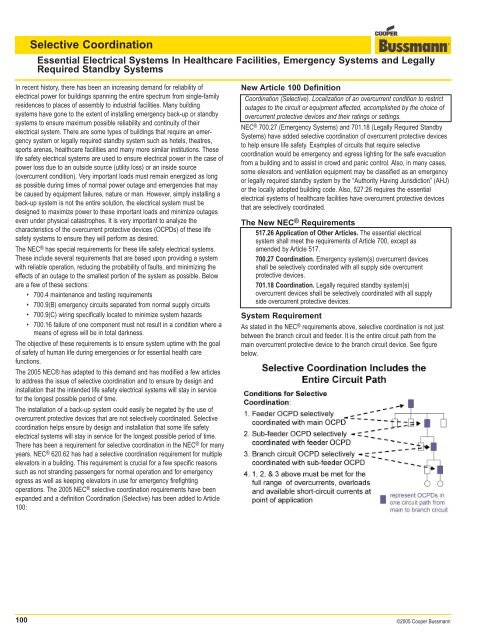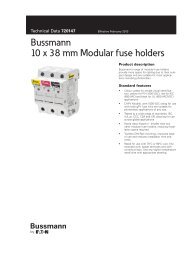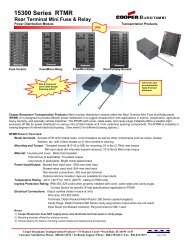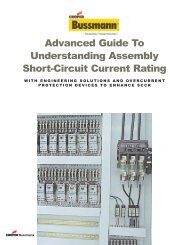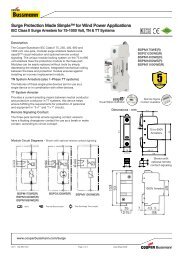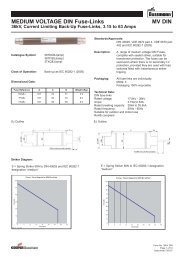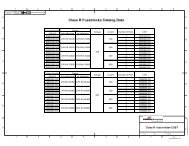Selective Coordination - Cooper Bussmann
Selective Coordination - Cooper Bussmann
Selective Coordination - Cooper Bussmann
Create successful ePaper yourself
Turn your PDF publications into a flip-book with our unique Google optimized e-Paper software.
<strong>Selective</strong> <strong>Coordination</strong>Essential Electrical Systems In Healthcare Facilities, Emergency Systems and LegallyRequired Standby SystemsIn recent history, there has been an increasing demand for reliability ofelectrical power for buildings spanning the entire spectrum from single-familyresidences to places of assembly to industrial facilities. Many buildingsystems have gone to the extent of installing emergency back-up or standbysystems to ensure maximum possible reliability and continuity of theirelectrical system. There are some types of buildings that require an emergencysystem or legally required standby system such as hotels, theatres,sports arenas, healthcare facilities and many more similar institutions. Theselife safety electrical systems are used to ensure electrical power in the case ofpower loss due to an outside source (utility loss) or an inside source(overcurrent condition). Very important loads must remain energized as longas possible during times of normal power outage and emergencies that maybe caused by equipment failures, nature or man. However, simply installing aback-up system is not the entire solution, the electrical system must bedesigned to maximize power to these important loads and minimize outageseven under physical catastrophes. It is very important to analyze thecharacteristics of the overcurrent protective devices (OCPDs) of these lifesafety systems to ensure they will perform as desired.The NEC ® has special requirements for these life safety electrical systems.These include several requirements that are based upon providing a systemwith reliable operation, reducing the probability of faults, and minimizing theeffects of an outage to the smallest portion of the system as possible. Beloware a few of these sections:• 700.4 maintenance and testing requirements• 700.9(B) emergency circuits separated from normal supply circuits• 700.9(C) wiring specifically located to minimize system hazards• 700.16 failure of one component must not result in a condition where ameans of egress will be in total darkness.The objective of these requirements is to ensure system uptime with the goalof safety of human life during emergencies or for essential health carefunctions.The 2005 NEC® has adapted to this demand and has modified a few articlesto address the issue of selective coordination and to ensure by design andinstallation that the intended life safety electrical systems will stay in servicefor the longest possible period of time.The installation of a back-up system could easily be negated by the use ofovercurrent protective devices that are not selectively coordinated. <strong>Selective</strong>coordination helps ensure by design and installation that some life safetyelectrical systems will stay in service for the longest possible period of time.There has been a requirement for selective coordination in the NEC ® for manyyears. NEC ® 620.62 has had a selective coordination requirement for multipleelevators in a building. This requirement is crucial for a few specific reasonssuch as not stranding passengers for normal operation and for emergencyegress as well as keeping elevators in use for emergency firefightingoperations. The 2005 NEC ® selective coordination requirements have beenexpanded and a definition <strong>Coordination</strong> (<strong>Selective</strong>) has been added to Article100:New Article 100 Definition<strong>Coordination</strong> (<strong>Selective</strong>). Localization of an overcurrent condition to restrictoutages to the circuit or equipment affected, accomplished by the choice ofovercurrent protective devices and their ratings or settings.NEC ® 700.27 (Emergency Systems) and 701.18 (Legally Required StandbySystems) have added selective coordination of overcurrent protective devicesto help ensure life safety. Examples of circuits that require selectivecoordination would be emergency and egress lighting for the safe evacuationfrom a building and to assist in crowd and panic control. Also, in many cases,some elevators and ventilation equipment may be classified as an emergencyor legally required standby system by the “Authority Having Jurisdiction” (AHJ)or the locally adopted building code. Also, 527.26 requires the essentialelectrical systems of healthcare facilities have overcurrent protective devicesthat are selectively coordinated.The New NEC ® Requirements517.26 Application of Other Articles. The essential electricalsystem shall meet the requirements of Article 700, except asamended by Article 517.700.27 <strong>Coordination</strong>. Emergency system(s) overcurrent devicesshall be selectively coordinated with all supply side overcurrentprotective devices.701.18 <strong>Coordination</strong>. Legally required standby system(s)overcurrent devices shall be selectively coordinated with all supplyside overcurrent protective devices.System RequirementAs stated in the NEC ® requirements above, selective coordination is not justbetween the branch circuit and feeder. It is the entire circuit path from themain overcurrent protective device to the branch circuit device. See figurebelow.100 ©2005 <strong>Cooper</strong> <strong>Bussmann</strong>


